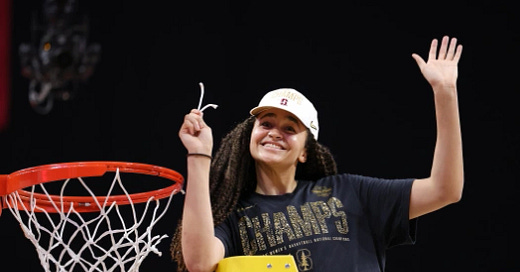NIL and Pay Disparity
It’s College Basketball Week here at Undrafted! In honor of March Madness, we’re doing a week of all college basketball content, with a new post dropping (hopefully) every day. On Monday we looked at what the Tournament teaches us about meritocracy; on Tuesday, we looked at Antoine Davis’ pursuit of Pete Maravich. Yesterday was the Lefty Specialists’ take on this year’s bracket. And today we’re talking about NIL and pay equity.
There was a brief moment, in the beginning of the NIL era, when it looked like Name Image Likeness deals would be a women’s college sports, which are so often forced to get by on a small fraction of the resources devoted to the men’s game. For basketball in particular, the women’s game has been much better at minting stars for probably a decade. I’m not sure any recent men’s player, other than maybe Zion Williamson, has reached the levels of fame that people like Caitlin Clark and Haley Jones have. And so, unsurprisingly, one of the first athletes to cash in on the NIL bonanza was Paige Bueckers, who reportedly earned more than the top nine men’s stars combined.*
*In general, we should be wary of the numbers assigned to NIL deals and earnings. The details of most deals are not public, and when you look closely at stories about them you often find that the numbers are generated through some speculative algorithm based on their Instagram impressions. For this piece I’ve tried to rely on reporting that seems more credible and points to larger trends, but overall it’s just not an area with much transparency or any incentives to be honest.
As time has gone on, though, and more data has come out, it’s clear that a pay gap exists between men and women’s sports. Measuring this is a little hard, because of football. Predictably, most of the money for college sports has flowed to college football, of which there is no female equivalent, so the lion’s share of money is going to male athletes. But even when you factor that out, the gap persists. Perhaps most troubling is the way that the NIL collectives, which have now been launched by virtually every major athletic department in the country to allow donors and/or advertisers funnel money to college athletes, may end up circumventing Title IX rules about funding women’s sports.
But how can this be? How can women as a whole be underpaid while so many of basketball’s biggest stars are women?
The answer is that the fate of stars has very little to do with the fate of a class as a whole. You might think this would be obvious, but so many conversations about equity are focused on only the top end of the spectrum, on the outliers in any group of people. There is so much focus on whether there are enough women CEOs, or Asian American movie stars, or Black students at Harvard…even those experiences are not at all representative of the average worker or actor or college student. No matter what the subject, we’re always focused on the fates of “stars.”
The generous interpretation of this — and the one many liberals would default to — is that “representation matters.” It matters what happens to stars because they are the most prominent, visible examples of any group, and so they help illustrate what is possible for all of us. There may be some truth to this, but I think it is dramatically overstated. (Isn’t It strikes pretty condescending to insist that normal people need to see “people who look like me” in positions of power and success before they can imagine being successful themselves?)
But even if it is inspiring to watch others succeed, it says nothing about the conditions facing a group as a whole. Or put another way, the fact that Paige Bueckers has cashed in does not make your average women’s college basketball player any richer.
The other problem with the focus on stars is that it furthers the divide between star players and average athletes. In other words, it undermines the class solidarity between all workers. Once Bueckers et al get their money, it’s easy for people to move on and forget about the lesser-known players who are still being exploited by their schools. This isn’t the fault of the stars themselves — it’s just that NIL is not a system conducive to collective success, a problem I’ve written about before.
But there actually IS a way for stars to leverage their power and earning potential on behalf of the whole class of workers of which they are a part. It’s called a union, and maybe college athletes should try it.



